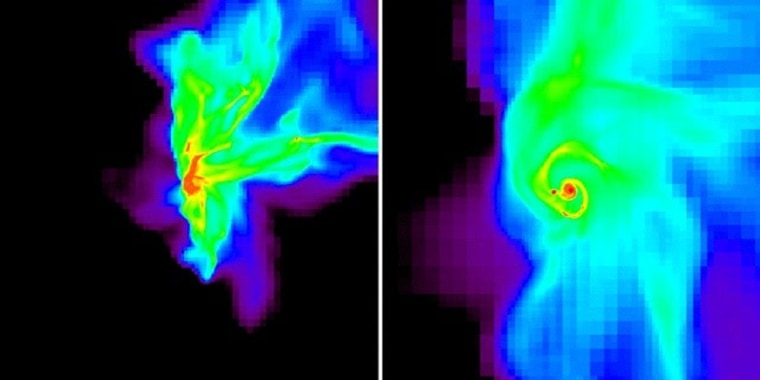Hollywood megastars need just right the right conditions to explode onto the scene, a phenomenon shared by rare supermassive celestial stars.
Two scientists think they have decoded the gassy recipe to create stars as much as 100 times bigger than the sun, perhaps solving the mystery of their formation. Mark Krumholz of Princeton University in New Jersey and his colleague Christopher McKee of the University of California Berkeley used mathematical models to show how small stars can prime superstar formation.
"Gravity tends to break interstellar gas clouds into small pieces, preventing massive star formation," Krumholz said. "But little stars heating up a gas cloud can smooth it out, forcing gravity to create a huge star."
Krumholz and McKee detail their findings in the Feb. 28 issue of the journal Nature.
Star power
Although massive stars are about a million times rarer than the most common stars — those about 80 percent smaller than the sun — they are the movers and shakers of the universe.
"They're very rare, but massive stars are the dominant players in galaxies," Krumholz said. "They're the things that can push around and heat up interstellar gas, which is essentially where all stars come from."
He also explained that big stars seed the cosmos with elements that are required for life.
"They enrich the universe with metals from their supernovae," he said, noting that only enormous stars are powerful enough to fuse together small atoms and create the heavy materials.
Hot influence
To form a galactic superpower, Krumholz said an interstellar gas cloud needs to be thousands of times more dense than average. Problem is, gravity tends to break dense gas clouds into pieces and thwart massive star formation.
"The challenge isn't getting enough gas, it's getting the cloud into a small enough region and preventing its breakup," he said.
If a few small stars form within the cloud, Krumholz explained, they can heat up the cloud and increase its "column density," or pressure. The heating process prevents gravity from taking control of the cloud, breaking it up and forming only small stars.
"Heating up the gas helps pressure win over gravity's influence, ultimately forcing the gas cloud to collapse in a massive star," Krumholz said.
The new view of star formation highlights the rarity of massive stars — the only kind astronomers on Earth can see in distant galaxies — but leads to the possibility that more stars form in galaxies than previously thought.
"There may be significant parts of galaxies where massive stars can't form, but lower-mass stars like the sun can," Krumholz said. "We estimate the number of stars in a galaxy on the amount of light we see, and if massive stars are missing, then it's possible that we've dramatically underestimated the rate of star formation in distant regions of the universe."
